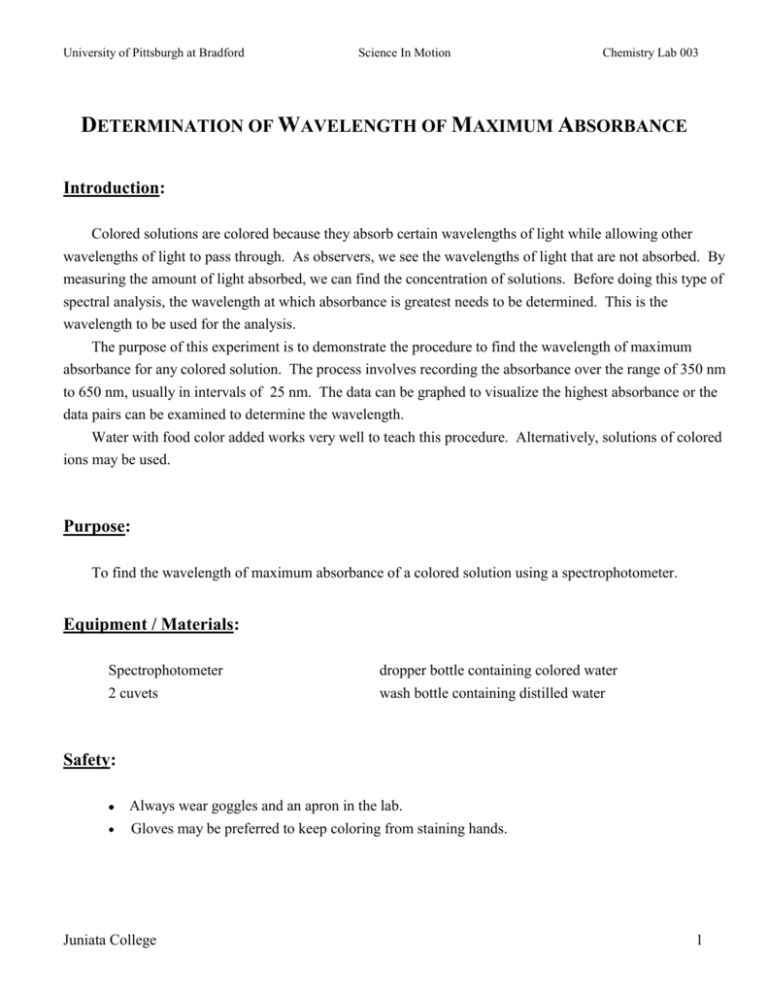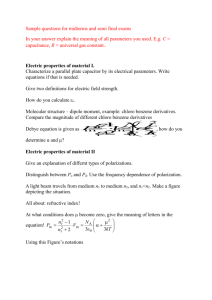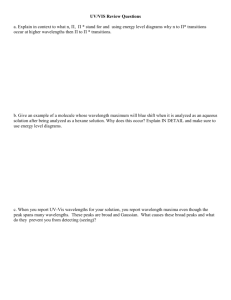DETERMINATION OF WAVELENGTH OF MAXIMUM ABSORBANCE
advertisement

University of Pittsburgh at Bradford Science In Motion Chemistry Lab 003 DETERMINATION OF WAVELENGTH OF MAXIMUM ABSORBANCE Introduction: Colored solutions are colored because they absorb certain wavelengths of light while allowing other wavelengths of light to pass through. As observers, we see the wavelengths of light that are not absorbed. By measuring the amount of light absorbed, we can find the concentration of solutions. Before doing this type of spectral analysis, the wavelength at which absorbance is greatest needs to be determined. This is the wavelength to be used for the analysis. The purpose of this experiment is to demonstrate the procedure to find the wavelength of maximum absorbance for any colored solution. The process involves recording the absorbance over the range of 350 nm to 650 nm, usually in intervals of 25 nm. The data can be graphed to visualize the highest absorbance or the data pairs can be examined to determine the wavelength. Water with food color added works very well to teach this procedure. Alternatively, solutions of colored ions may be used. Purpose: To find the wavelength of maximum absorbance of a colored solution using a spectrophotometer. Equipment / Materials: Spectrophotometer 2 cuvets dropper bottle containing colored water wash bottle containing distilled water Safety: Always wear goggles and an apron in the lab. Gloves may be preferred to keep coloring from staining hands. Juniata College 1 Procedure: 1. Select a dropper bottle containing one of the four available colored solutions. 2. Hold cuvet by the rough sides. Rinse the cuvet with a small amount of the colored solution and then fill the cuvet 3/4 full. 3. Fill the second cuvet with distilled water to be used as a blank. 4. Press A/T/C Button on the Spectronic 20 Genesys. Select absorbance. 5. Press the nm arrow up or down and select 350 nm. 6. Insert the blank into the cell holder and close the door. Position the cell so that the light passes through clear walls. 7. Press 0 ABS/100% T to set the blank to 0 A. 8. Remove the blank and insert sample into the cell holder. The sample measurement appears on the LCD display. Record the absorbance on the data sheet. 9. Reset the wavelength to 375 nm and repeat steps 6, 7, and 8. 10. Repeat steps 5, 6, 7 and 8, recording absorbances at every 25 nm using this technique until you reach 650 nm. 11. Locate the 50 nm region in which the absorbance is highest and record the absorbance every 10 nm in this region repeating steps 5, 6, 7 and 8. 12. Determine the wavelength of maximum absorbance by creating a graph of the data - placing wavelength on the x-axis and absorption on the y-axis. Questions: 1. What is the wavelength of maximum absorbance for each colored solution tested? 2. What color of light corresponds to the wavelength of maximum absorbance for each colored solution tested? Name_______________________________ Juniata College 2 Period______________________________ Date________________________________ DETERMINATION OF WAVELENGTH OF MAXIMUM ABSORBANCE Data Table: Color of solution _______________________________ wavelength (nm) absorbance wavelength absorbance (nm) 350 375 400 425 450 475 500 525 550 575 600 625 650 Juniata College 3











